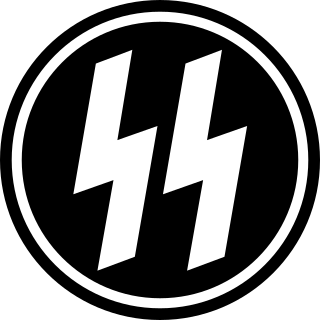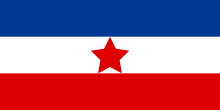
Central Serbia, also referred to as Serbia proper, is the region of Serbia lying outside the autonomous province of Vojvodina to the north and the autonomous province of Kosovo and Metohija to the south. Central Serbia is a term of convenience, not an administrative division of Serbia as such, and does not have any form of separate administration.
The Serbian Volunteer Corps, also known as Ljotićevci, was the paramilitary branch of the fascist political organisation Zbor, and collaborated with the forces of Nazi Germany in the German-occupied territory of Serbia during World War II.

The Territory of the Military Commander in Serbia was the area of the Kingdom of Yugoslavia that was placed under a military government of occupation by the Wehrmacht following the invasion, occupation and dismantling of Yugoslavia in April 1941. The territory included only most of modern central Serbia, with the addition of the northern part of Kosovo, and the Banat. This territory was the only area of partitioned Yugoslavia in which the German occupants established a military government. This was due to the key rail and the Danube transport routes that passed through it, and its valuable resources, particularly non-ferrous metals. On 22 April 1941, the territory was placed under the supreme authority of the German military commander in Serbia, with the day-to-day administration of the territory under the control of the chief of the military administration staff. The lines of command and control in the occupied territory were never unified, and were made more complex by the appointment of direct representatives of senior Nazi figures such as Reichsführer-SS Heinrich Himmler, Reichsmarschall Hermann Göring, and Reichsminister Joachim von Ribbentrop. The Germans used Bulgarian troops to assist in the occupation, but they were at all times under German control. Sources variously describe the territory as a puppet state, a protectorate, a "special administrative province", or describe it as having a puppet government. The military commander in Serbia had very limited German garrison troops and police detachments to maintain order, but could request assistance from a corps of three divisions of poorly-equipped occupation troops.

The 1st Belgrade Special Combat detachment was a special police unit which was established by the German Gestapo in the Territory of the Military Commander in Serbia during World War II.

The Banat was a political entity established in 1941 after the occupation and partition of Yugoslavia by the Axis Powers in the historical Banat region. It was formally under the control of the German puppet Government of National Salvation in Belgrade, which theoretically had limited jurisdiction over all of the Territory of the Military Commander in Serbia, but all power within the Banat was in the hands of the local minority of ethnic Germans (Volksdeutsche). The regional civilian commissioner and head of the ethnic German minority was Josef Lapp. Following the ousting of Axis forces in 1944, this German-ruled region was dissolved and most of its territory was included into Vojvodina, one of the two autonomous provinces of Serbia within the new SFR Yugoslavia.

Serbia's capital city of Belgrade is divided into 17 municipalities.

The Belgrade offensive or the Belgrade strategic offensive operation was a military operation during World War II in Yugoslavia in which Belgrade was liberated from the German Wehrmacht through the joint efforts of the Soviet Red Army, Yugoslav Partisans, and the Bulgarian Army. Soviet forces and local militias launched separate but loosely cooperative operations that undermined German control of Belgrade and ultimately forced a retreat. Martial planning was coordinated evenly among command leaders, and the operation was largely enabled through tactical cooperation between Josip Broz Tito and Joseph Stalin that began in September 1944. These martial provisions allowed Bulgarian forces to engage in operations throughout Yugoslav territory, which furthered tactical success while increasing diplomatic friction.

Sima Ćirković was a Yugoslav and Serbian historian. Ćirković was a member of the Academy of Sciences and Arts of Bosnia and Herzegovina, the Yugoslav Academy of Sciences and Arts, the Montenegrin Academy of Sciences and Arts, the Serbian Academy of Sciences and Arts and the Vojvodina Academy of Sciences and Arts. His works focused on medieval Serbian history.
The Government of National Salvation, also referred to as Nedić's government or Nedić's regime, was the colloquial name of the second Serbian collaborationist puppet government established after the Commissioner Government in the German-occupied territory of Serbia during World War II in Yugoslavia. Appointed by the German Military Commander in Serbia, it operated from 29 August 1941 to 4 October 1944. Unlike the Independent State of Croatia, the regime in occupied Serbia was never accorded status in international law and did not enjoy formal diplomatic recognition of the Axis powers.

During World War II, several provinces of the Kingdom of Yugoslavia corresponding to the modern-day state of Serbia were occupied by the Axis Powers from 1941 to 1944. Most of the area was occupied by the Wehrmacht and was organized as separate territory under control of the German Military Administration in Serbia. Other parts of modern Serbia that were not included in the German-administered territory were occupied and annexed by neighboring Axis countries: Syrmia was occupied and annexed by the Independent State of Croatia, Bačka was occupied and annexed by Hungary, southeastern Serbia was occupied and annexed by Bulgaria, and southwestern Serbia was occupied and annexed by Italy and included in the Italian protectorates of Albania and Montenegro.
The Allied bombing of Yugoslavia in World War II involved air attacks on cities and towns in the Kingdom of Yugoslavia by the United States Army Air Force (USAAF) and Royal Air Force (RAF), including the Balkan Air Force (BAF), between 1941 and 1945, during which period the entire country was occupied by the Axis powers. Dozens of Yugoslav cities and towns were bombed, many repeatedly. These attacks included intensive air support for Yugoslav Partisan operations in May–June 1944, and a bombing campaign against transport infrastructure in September 1944 as the German Wehrmacht withdrew from Greece and Yugoslavia. This latter operation was known as Operation Ratweek. Some of the attacks caused significant civilian casualties.

The Operation Draufgänger was a German Wehrmacht military operation against the Yugoslav Partisans at the Montenegrin-Serbian border area, aimed at breaking the Partisan foothold on the Lim river which was a potential penetration point into Serbia. In turn, it was a Partisan counter-operation, known as the Andrijevica Operation. The operation began on 18 July on the Čakor–Gusinje–Andrijevica–Berane line, when Kampfgruppe E burnt down at least 16 villages and killed several hundreds inhabitants. From different directions, German troops attacked villages and a part approached Andrijevica, pushed out parts of two Partisan brigades, and then took over the town on 19 July and continued attacking. The staffs of the Partisan brigades assessed the combined German forces as inadequate and self-initiatively decided to attacks, resulting in great German losses. With the possibility to surround and destroy, the II Assault Corps gave the operational command on 23 July on general attack. From different directions the German troops were surrounded in the wider region of Murino on 24 July. On 28 July the Partisan 2nd, 5th and 17th divisions were ordered to move across the Ibar, which gave the opportunity for the 14th Regiment SS to break through Čakor towards Peć, while larger part of the 21st Division SS broke and many Albanians deserted. The German troops were decisively defeated, and the Partisans moved for action in Serbia. Operation Rübezahl followed.

The 6th Proletarian Assault Lika Division "Nikola Tesla" was a Yugoslav Partisan division formed on 22 November 1942. It was formed from the 1st, 2nd, and 3rd Lika Brigades. On 11 November 1943, it became part of the 4th Corps and later a part of the 1st Corps. It operated in Dalmatia until November 1943 when it crossed into Bosnia, later it fought in Serbia and on the Syrmian Front. From October 1944, the 22nd Serbian Kosmaj Brigade also fought as part of the division, and in December 1944 an Artillery Brigade was formed within the division.

The 17th East Bosnia Assault Division was Yugoslav Partisan division formed on 2 July 1943. The division was formed from the 6th East Bosnia Brigade, the 1st Majevica Brigade and Majevica Detachment. Gligorije Mandić was a commander of the division while its political commissar was Branko Petričević. The division was under the direct command of the Supreme Headquarters until 20 September 1943 when it came under the command of the 3rd Corps. During a brief time in May and June 1944, it was again under the command of the Supreme Headquarters, following that it became a part of the 2nd Corps. The division mostly fought in Bosnia and Serbia.

The 22nd Serbia Division was a Yugoslav Partisan division formed on 22 May 1944 as the 2nd Serbia Division. It was formed from three brigades, those being the 8th, 10th and 12th Serbia Brigades whose total strength was around 2,000 fighters. Commander of the division was Živojin Nikolić Brka while its political commissar was Vasilije Smajević. The division fought mostly in Serbia but it also participated in battles of Syrmian Front and Final Operations.

The 23rd Serbia Division was a Yugoslav Partisan division formed on 6 June 1944 as the 3rd Serbia Division in Toplica. It was formed from the 7th and 9th Serbia Brigades. On 17 June 1944, the 14th Serbia Brigade was added to the division which at the time numbered around 2,000 soldiers. The division was under the direct command of the Supreme Headquarters until 6 September 1944 when it became part of the 14th Corps. On 9 December 1944, it came under the command of the Southern Operational Group and in January 1945 it became part of the 2nd Army.

The 24th Serbia Division was a Yugoslav Partisan division formed on 10 June 1944 as the 4th Serbia Division in Jablanica. It was formed from the 11th and 17th Serbia Brigades which numbered around 2000 fighters in total. Soon after the formation the 13th and the 15th Serbia Brigades were also added to the division. The division was under the direct command of the Supreme Headquarters until 6 September 1944 when it became a part of the 13th Corps. Its commander was Mile Čalović while its political commissar was Dimitrije Vrbica.

The 25th Serbia Division was a Yugoslav Partisan division formed on 10 June 1944 in Jošanica. It was formed from the 16th, 18th and 19th Serbia Brigades. Upon formation it had around 3,000 soldiers, it grew to around 12,000 by December 1944. The division was direct command of the Supreme Headquarters until 6 September 1944. It became a part of the 2nd Army in January 1945.

The 5th Krajina Division was a Yugoslav Partisan division formed in Glamočko polje on 9 November 1942.









